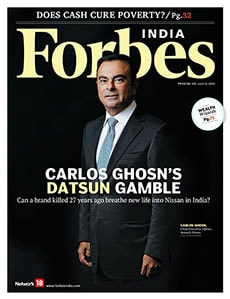
The Reincarnation of a Brand
The bulk of the work on the Datsun revival is being done locally, in India, Indonesia and Russia
How do you breathe new life into a brand you intentionally killed? Over the next few months and years, we will have at least one such case study on our hands, as Nissan Motor Company of Japan unveils the rebirth of its Datsun brand for the emerging markets. On July 15, Carlos Ghosn, CEO of the Renault-Nissan Alliance, will be in New Delhi for the event, and, in a brief message to Forbes India, he told us about Nissan’s ambitions. “Datsun has been the strength of Nissan and we aim to revive our strength…It is a global brand and our priority will be to concentrate on India, Indonesia and Russia.”

Ashish Mishra, Forbes India’s resident auto buff, talked to the people behind the forthcoming reincarnation of Datsun—from the project head in Japan to the local spearhead in India—to put together a fascinating story on how they went about reviving a nameplate that was last put on an automobile body in the 1980s. Says Mishra: “What is interesting about the Datsun project is that the spearhead team in Japan is very small—just 17 people. The bulk of the work is being done locally, in India, Indonesia and Russia. A good example of thinking global and acting local.”
At Forbes India, we believe that change is the only constant. While we don’t set out to reinvent every wheel—you don’t need to do that when you have a world-beating brand on the front cover—we do constantly review what works and what doesn’t for our readers, based on feedback and comments. In this issue, we are launching a shorter, snackier front section called Check-In. Do check it out and let us know what you think.
Our Design Director Anjan Das is a restless soul constantly fretting about how to make the magazine more accessible, more appealing to the reader. Even as our editors are constantly battling with him to squeeze more wordage into available space, Das is busy doing the opposite—getting rid of excess verbiage to let fonts breathe. Hear him on this: “We have refreshed the photography style and made the layouts cleaner by intelligent use of white space. The new template of Forbes India is a mash-up of modern and tailored typography (combination of serif and sans serif fonts), along with primary colour schemes used mainly as a counterpoint. We wanted to make Forbes India look closer to other Forbes editions across the world.”
I wouldn’t call it a redesign, but a tweak to make things better for the reader. We hope you do like the changes. We would like it best if you have not noticed it at all. We don’t want to jolt you every fortnight with something you didn’t expect.
Best,
R Jagannathan
Editor-in-Chief, Forbes India
Email: r.jagannathan@network18online.com
Twitter id: @TheJaggi
(This story appears in the 12 July, 2013 issue of Forbes India. To visit our Archives, click here.)














